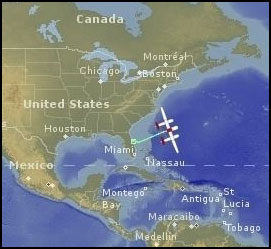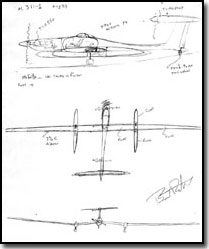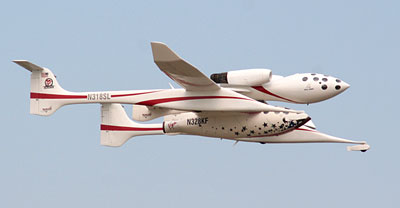GlobalFlyer and Fossett takeoff
Posted By RichC on February 8, 2006
 Steve Fossett took off in an experimental plane today at 7:20 a.m. on an 80-hour flight. He hopes to set a nonstop distance record in the GlobalFlyer aircraft sponsored by Richard Branson’s Virgin Atlantic Airways.
Steve Fossett took off in an experimental plane today at 7:20 a.m. on an 80-hour flight. He hopes to set a nonstop distance record in the GlobalFlyer aircraft sponsored by Richard Branson’s Virgin Atlantic Airways.
Steve Fossett, is a 61 year old excentric millionaire who has “ballooned” (pun intended) his way to fame in a variety of ways including flying and sailing, is out to break the record by some 700 odd miles set by Dick Rutan and Jeana Yeager, a 26,366-mile nonstop distance record set in 1986. After taking off from Florida, he will fly over the Atlantic, cross Africa, Saudi Arabia, India, China, Japan, the Pacific Ocean, Mexico, and the United States and then back over the Atlantic before landing at Kent International Airport outside London.
 The GlobalFlyer, which is built by Scaled Composites need to climb to an altitude of about 45,000 feet to take advantage of the naturally occurring high-speed jet stream flowing from the west to the east over the Northern Hemisphere. The GlobalFlyer has a single engine and must have cool temperatures at takeoff in order to get the plane’s weight of more than 11 ton off the runway. Success at least the takeoff. (Check out Burt Rutan’s original napkin sketch prior to designing the GlobalFlyer to the left) 🙂
The GlobalFlyer, which is built by Scaled Composites need to climb to an altitude of about 45,000 feet to take advantage of the naturally occurring high-speed jet stream flowing from the west to the east over the Northern Hemisphere. The GlobalFlyer has a single engine and must have cool temperatures at takeoff in order to get the plane’s weight of more than 11 ton off the runway. Success at least the takeoff. (Check out Burt Rutan’s original napkin sketch prior to designing the GlobalFlyer to the left) 🙂
Interested internet watchers can track the flight on the Virgin Atlantic mission control site during the 80 hour trip. Below is a photo I took this past summer while in Oshkosh Wisconsin for Airventure. (the wingspan was enormous!)

EDIT: 2006-02-08 – 16:05est
Updated as a reader asked me a few question about the Global Flyer. (see below) In the meantime, Steve Fossett is over the Canary Island just off the coast of Africa. He is experiencing mild turbulance at 40,000 feet and traveling at 300 knots.
Info on the Global Flyer:
Scaled’s ‘Model 311’ aircraft is a single engine turbofan aircraft specifically designed for non-stop global circumnavigation by a solo pilot with no passengers. The ‘Voyager’ aircraft which took Dick Rutan and Jeanna Yeager around the world non-stop could well be considered 311’s ‘big sister’, but evolution and invention on the part of Burt himself and Jon Karkow has certainly played its part in making this aircraft unique.
Aerodynamics are key to this aircraft, and its configuration is optimised for range and fuel efficiency. The aircraft’s aerodynamics have been designed using extremely sophisticated computing technology that uses computational fluid dynamics to predict how the aircraft’s surfaces will behave in flight. The aircraft is so aerodynamically perfect, that the only practical way to descend is using drag parachutes, like the ones in the picture above. As the aircraft is only required to land once, these won’t be detachable and will take time to reset.The wing structure revealed during the construction phase.
The aircraft is a trimaran-like construction with two huge external ‘booms’ which hold the landing gear, and 5,454 pounds of fuel on either side of the pilot’s cockpit in the centre on top of which is the single Williams turbofan jet engine. The construction materials used for the structure of this aircraft are all graphite/epoxy. The stiffest carbon fibers are used in the construction of the wings, and the skin is a sandwich of graphite/epoxy and Aramid honeycomb.
The aircraft doesn’t have what is known as ‘deicing’ or ‘anti-ice’ measures. This means that it will be unable to fly in ‘icing’ conditions. In addition, it won’t cope with turbulence very well in the early part of the flight when the aircraft is heavy and structural margins low; so weather will be an important factor in choosing when and where to take off from.
The pilot, Steve, will sit in the main fuselage, the centre pod, just behind the nose landing gear and below the engine. He’ll also be sitting in front of the main fuel header tank which feeds the engine.
Advanced aerodynamic design accounts for the engine’s outstanding fuel economy at altitude, which makes the Williams FJ44 the ideal engine for the GlobalFlyer. In fact, it is the only engine with sufficient thrust-to-weight ratio and fuel economy to enable GlobalFlyer’s record-setting flights. Although remarkably quiet by jet engine standards, the engine is located so close to the pilot that sound deadening had to be added to the cockpit.
Steve will also be sitting in a pressurised cabin because of the altitude he will be flying at, which will give him a ‘cabin altitude’ of 10,000 feet at the 45,000 feet he’ll actually be flying at.
One mean machine!The cockpit itself is a mere 7 feet long. It is equipped with a reclining carbon fiber seat. However, to get a good enough view for take off and landing, Steve will need to sit on cushions as the seat isn’t high enough.
There are thirteen fuel tanks all in all, and on take-off, it is expected that this aircraft will be 83% fuel by weight. Which must be a world record surely? Getting fuel to where it’s needed whilst maintaining the balance and stability of the aircraft is a feat that will require constant supervision and monitoring. The fuel itself will be a special fuel that has a much lower freezing point that regular aviation fuel.
Some facts and figures:
– Wing Span: 114ft
– Wing Area: 400ft squared
– Length: 44.1ft
– Height: 13.3ft
– Gross Weight: 22,000 lbs
– Empty Weight: 3,350 lbs
Comments